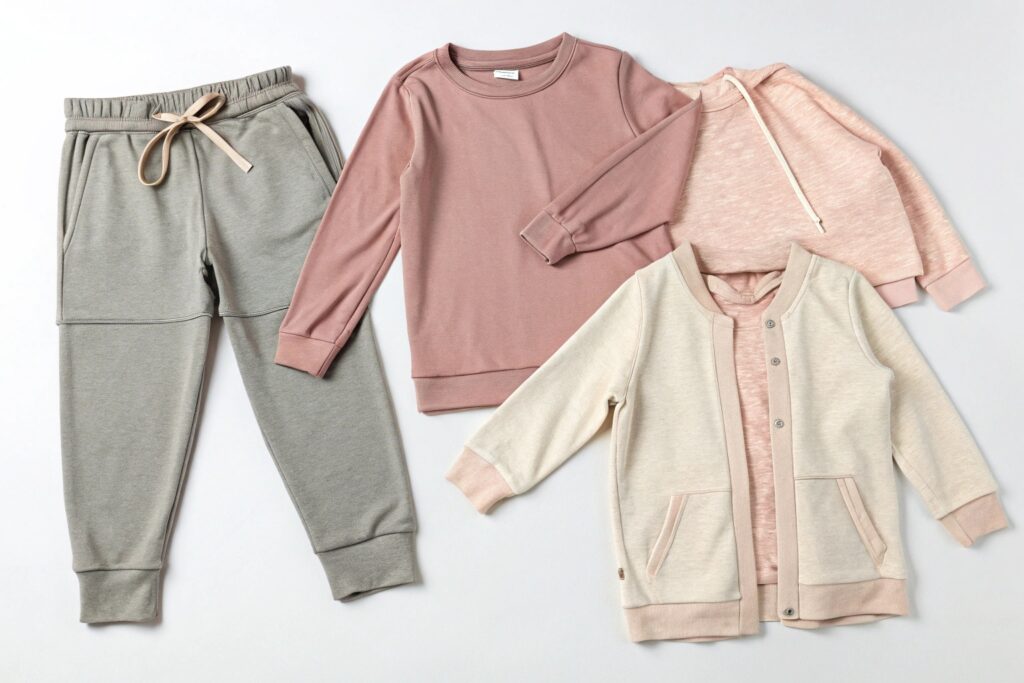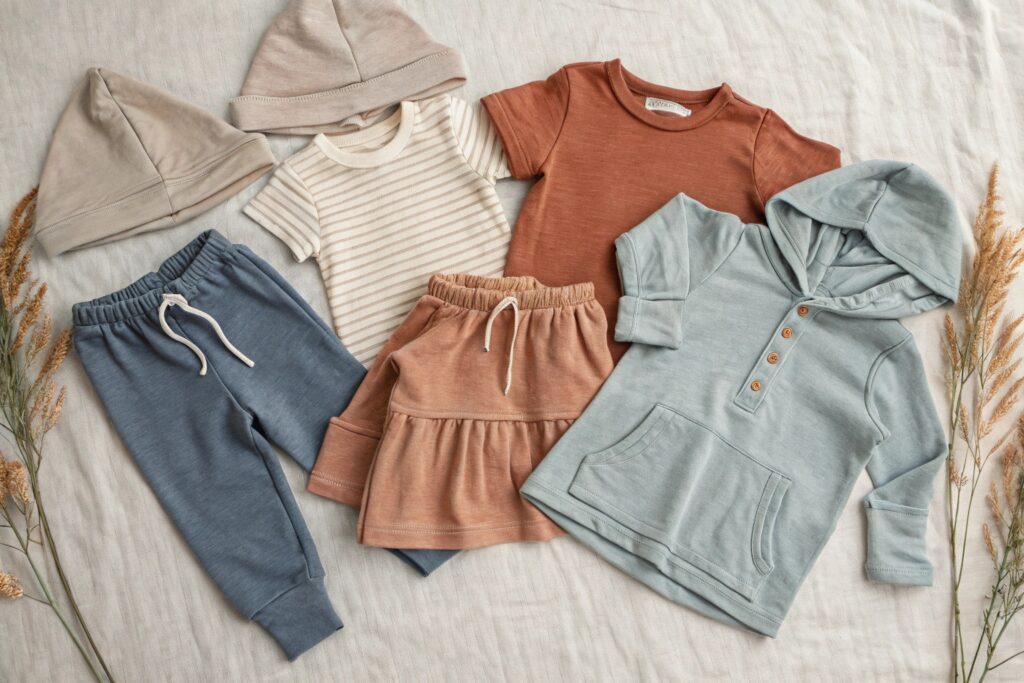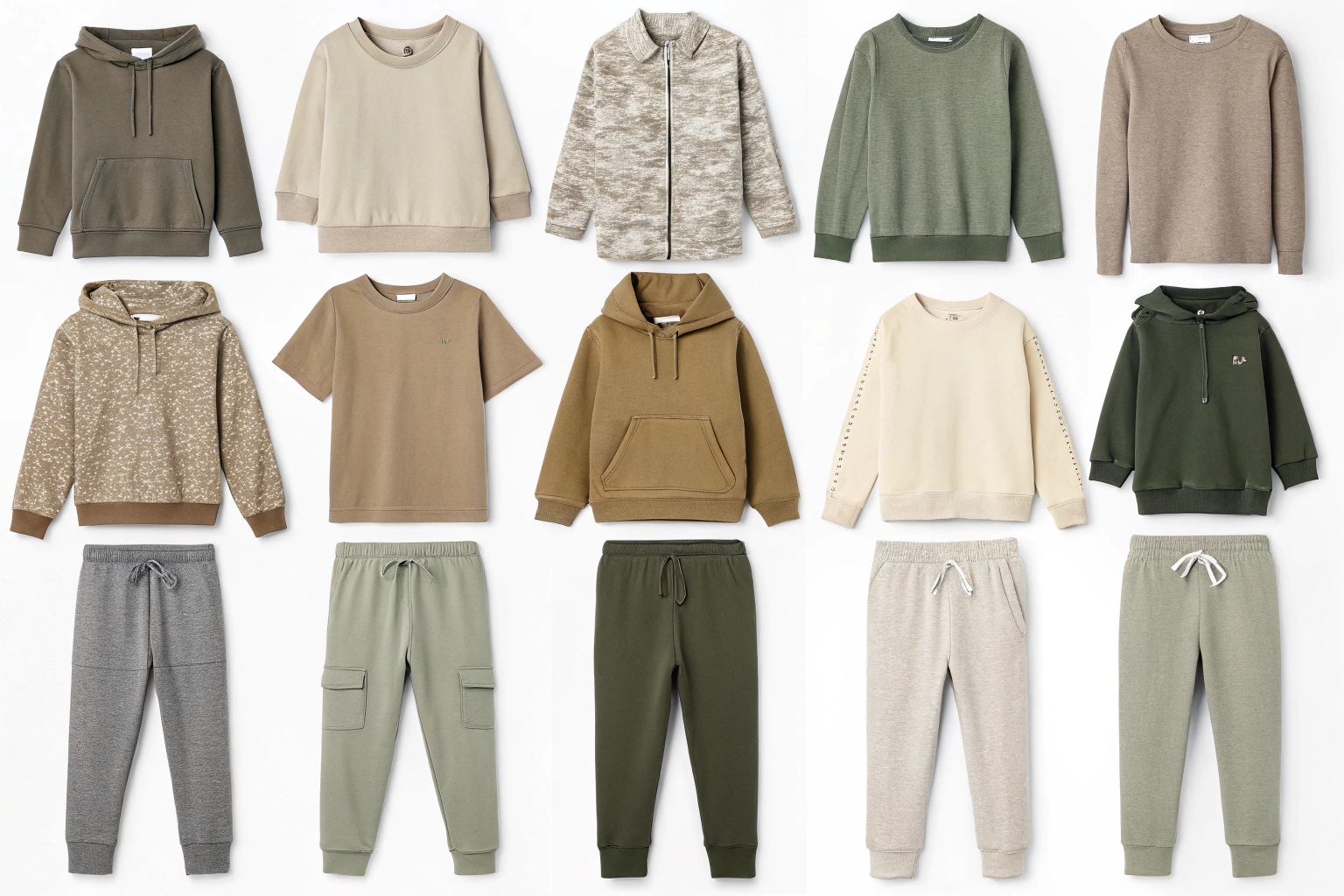Kids grow fast and change outfits even faster. Keeping up with their wardrobe needs without overflowing the closet can be a real challenge.
The secret to an efficient kids’ wardrobe is learning how to mix and match capsule pieces—so you get more outfits, more value, and less stress.
As someone who’s helped dozens of brands build smart capsule lines, I can tell you this: the key is creating flexible combinations that always work. Let me show you how.
Simple Outfit Formulas Using Kids’ Capsule Basics?
Too many choices can overwhelm both kids and parents. That’s why capsule wardrobes succeed—they simplify dressing through consistent structure.
Simple outfit formulas help parents and children pair pieces with ease, taking the guesswork out of getting dressed each day.

What Are Foolproof Outfit Combinations You Can Use Again and Again?
Here are four basic outfit formulas we often recommend to our clients building kidswear capsules:
- Tee + Bottom + Layer
- Graphic Top + Neutral Bottom + Accessory
- Dress + Leggings + Jacket
- Long Sleeve Tee + Vest + Joggers
These combinations work across all seasons by adjusting materials (cotton for spring, fleece for winter) and swapping in seasonal accessories like hats or scarves.
We often help clients build lookbooks that show these formulas in action using the same 5–7 core items. That visual support helps both buyers and end-customers feel confident in every piece.
How Can Brands Simplify These Formulas into Shopping Experiences?
Bundle your pieces into outfit-ready sets. Label combinations like:
- “Everyday Explorer Set”
- “Play & Picture Day Set”
- “3 Tops, 2 Bottoms, 1 Layer = 6 Looks”
Use these formulas to tell a story. Parents don’t just want clothes—they want ease. And giving them plug-and-play options makes that decision easier.
We’ve seen up to 40% better sell-through on capsule kits that follow this strategy.
Color Coordination Tips for Kids’ Mix-and-Match Wardrobes?
Mixing and matching only works when the colors are carefully chosen. Too many brights or clashing tones? Goodbye capsule logic.
Color coordination in kidswear capsules starts with 2–3 base tones, a couple of accent colors, and minimal high-contrast patterns.

What Color Strategies Work Best for Easy Mixing?
Here’s a proven framework we use with clients:
- Base Colors: Navy, Beige, Gray — These go with everything.
- Accent Colors: Mustard, Sage, Terracotta — Adds warmth and personality.
- Highlight Prints: Keep one pattern neutral enough to blend across all tones.
We recommend choosing one print per capsule and building solids that complement it. For example, a capsule with a rust-and-sage leaf print might include:
- Solid sage joggers
- Neutral oatmeal tee
- Rust tunic
- Leaf-printed leggings
- Sand cardigan
Any 3-piece combo from this set looks intentional. That’s the power of smart palette planning.
How Can Parents Use Color Codes to Encourage Self-Dressing?
Color-coding helps kids pick out matching pieces independently. One client we worked with added color tabs inside necklines—so kids could match blue-tag tops with blue-tag bottoms.
This works especially well for toddlers and early school-age children. It’s also helpful in stores and online shopping.
Brands who integrate this feature increase parental trust and reduce post-purchase friction.
Capsule dressing should be empowering—not frustrating.
How to Create Multiple Looks from Fewer Kids’ Pieces?
Capsule dressing doesn’t mean boring repetition. With just a few well-chosen items, you can create variety that keeps kids and parents excited.
To get the most from fewer pieces, vary silhouettes, layer smartly, and choose prints or textures that pop without overpowering.

What Strategies Help Maximize Outfit Variety?
We coach clients to design capsules with these diversity tools:
- Contrast in Shape: Mix slim-fit leggings with boxy tees.
- Reversible Items: One hoodie = two looks.
- Layer-Friendly Cuts: Tunics over leggings, cropped tees over long sleeves.
- Play with Accessories: Hats, scarves, belts change the vibe.
Let’s say your capsule includes:
- 2 T-shirts (solid + print)
- 1 long-sleeve top
- 1 pair of joggers
- 1 skirt with built-in shorts
- 1 hoodie
- 1 tunic dress
That’s 7 pieces. With smart layering and contrast styling, you can create 14+ combinations. For example:
- T-shirt + skirt + hoodie
- Tunic + leggings
- Long-sleeve + skirt
- T-shirt layered over long-sleeve + joggers
The combinations grow as the pieces grow more flexible.
How Can Brands Communicate This Value to Customers?
Use packaging inserts or product pages that show “7 Pieces, 14 Looks” layouts. One client of ours doubled their email click-through rate with an animated GIF showing all combos from a capsule drop.
Parents love seeing how every piece earns its keep. It’s budget-friendly fashion made visible.
We also offer brands lookbook templates and printable outfit charts to include in shipping boxes—turning the capsule into an educational tool.
Easy Layering Tricks to Maximize Outfit Variety
Layering doesn’t just add warmth—it multiplies outfit options and keeps kids looking fresh, even with fewer items.
The best layering strategies use proportion, texture, and fit to extend the life and range of each capsule piece.

What Are the Best Layer-Friendly Items in a Kid’s Capsule?
These pieces perform double duty:
| Layering Piece | Benefits | Works With |
|---|---|---|
| Long sleeve fitted tee | Base layer under everything | T-shirts, dresses, sweaters |
| Zip-up hoodie | Removable outerwear or midlayer | Tees, tanks, rompers |
| Tunic top | Can be layered over or under | Leggings, joggers |
| Sleeveless vest | Adds warmth without bulk | Hoodies, long sleeves |
| Jersey dress | Can become top with leggings | Adds new silhouette |
We also recommend using side-slit hems and hi-low cuts for easier layering without bulk.
How Can Layering Support Growth and Seasonal Changes?
This is one of the biggest advantages of capsule logic.
- Layer over in cooler months
- Peel down in summer
- Add length to short tops with long-line tanks
- Use tights under shorts or skirts
Layering stretches the lifespan of each piece and bridges size gaps. One size-too-short shirt becomes a base layer. A tunic becomes a dress one season and a long top the next.
We help brands design with this strategy from the start—adding extra hem depth, stretchy cuffs, and adjustable straps for seamless transitions.
Conclusion
Mix-and-match capsule dressing isn’t just for adults. With the right planning, kids can have flexible, fun wardrobes built from fewer, better pieces. At Fumao Clothing, we specialize in helping brands create smart capsules that kids love—and parents appreciate day after day.










